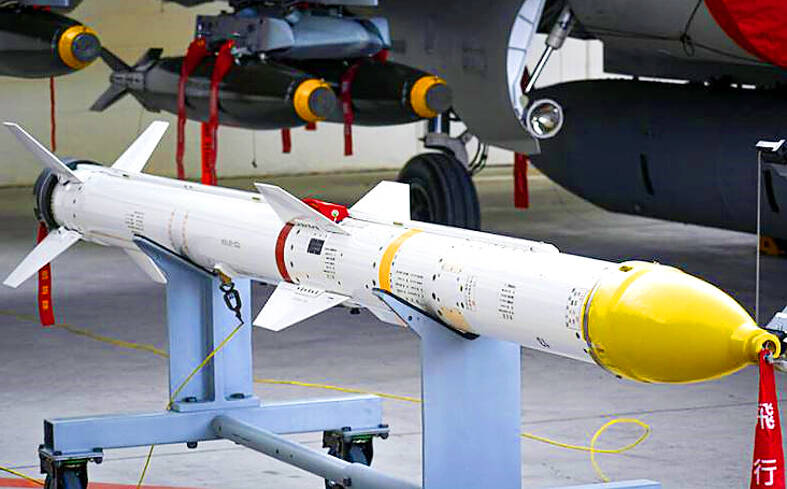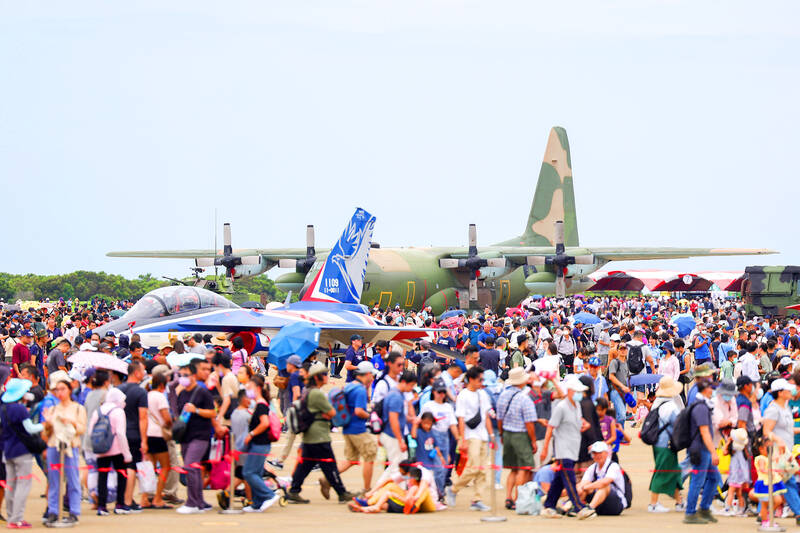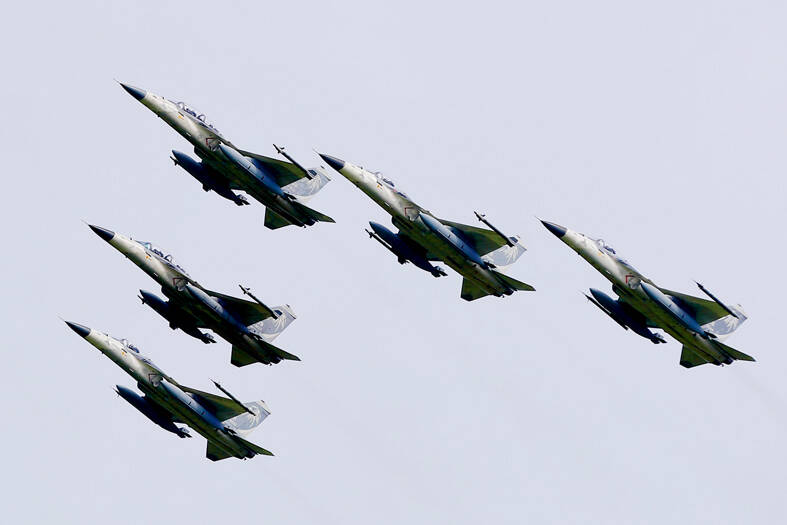The air force’s proposed next-generation fighter jet is to be armed with a new Tien Chien missile to be developed by the Chungshan Institute of Science and Technology, a high-ranking defense official said yesterday.
The missile, tentatively named Tien Chien V, is to have a range of 160km, equivalent to the US-made AIM-120C-8, the official said, speaking on condition of anonymity.
The weapon is based on the Tien Chien II medium-range air-to-air missile, they added.

Photo: Liu Yu-chieh, Taipei Times
Tien Chien V missiles would be compatible with domestically made joint helmet-mounted cueing systems and have improved anti-jamming capabilities, which would enhance the speed of target acquisition and pilots’ ability to counter enemy electronic warfare, the source said.
The new missile is needed to meet the next-generation fighter’s operational requirements and design parameters, as the air force has specified that the jet must utilize an internal weapons bay to enable stealth capabilities, they said.
The jet might incorporate vector thrust and advanced avionics, including active electronically scanned array radar and a tactical data link, they said, adding that the air force has yet to make a final decision on the platform’s capabilities.

Photo: Ritchie B. Tongo, EPA-EFE
The Chungshan Institute makes the Tien Chien I short-range air-to-air missiles and the medium-range Tien Chien II, in addition to the latter’s ship-launched and ground vehicle-mounted derivatives, which it refers to as Tien Chien III, the official said.
The developers skipped the name Tien Chien IV, they said.
Separately, President Tsai Ing-wen (蔡英文) yesterday said that a Ching Chuan Kang Air Base “open house” event in Taichung was intended to educate Taiwanese about the armed forces’ achievements in preparing the nation’s defense.

Photo: CNA
In a post on Facebook, Tsai called for support and appreciation for military service members.
After a three-year hiatus of the air shows due to the COVID-19 pandemic, this year’s open house featured a demonstration by the Thunder Tigers Aerobatics Team, a showcase of the military’s main combat aircraft, military band performances and displays that included nearly 100 stands.
Taiwan’s domestically designed AIDC T-5 Brave Eagle trainer jets conducted a flyover in a formation of five, marking a first for that type of aircraft.

Photo: Ritchie B. Tongo, EPA-EFE
Lockheed Martin F-16Vs, Dassault Mirage 2000s and AIDC Indigenous Defense Fighters were among the other tactical aircraft that carried out aerial demonstrations at the event.
The army and the navy, which also participated in the event, displayed vehicles and weapons systems currently in service, including the Boeing AH-64 Apache attack helicopter, Sikorsky UH-60 Black Hawk helicopter, armored fighting vehicles, Hsiung Feng II and Hsiung Feng III missiles, and the Chungshan Institute-developed Albatross drone and Cardinal uncrewed combat aerial vehicle.

The US government has signed defense cooperation agreements with Japan and the Philippines to boost the deterrence capabilities of countries in the first island chain, a report by the National Security Bureau (NSB) showed. The main countries on the first island chain include the two nations and Taiwan. The bureau is to present the report at a meeting of the legislature’s Foreign Affairs and National Defense Committee tomorrow. The US military has deployed Typhon missile systems to Japan’s Yamaguchi Prefecture and Zambales province in the Philippines during their joint military exercises. It has also installed NMESIS anti-ship systems in Japan’s Okinawa

‘WIN-WIN’: The Philippines, and central and eastern European countries are important potential drone cooperation partners, Minister of Foreign Affairs Lin Chia-lung said Minister of Foreign Affairs Lin Chia-lung (林佳龍) in an interview published yesterday confirmed that there are joint ventures between Taiwan and Poland in the drone industry. Lin made the remark in an exclusive interview with the Chinese-language Liberty Times (the Taipei Times’ sister paper). The government-backed Taiwan Excellence Drone International Business Opportunities Alliance and the Polish Chamber of Unmanned Systems on Wednesday last week signed a memorandum of understanding in Poland to develop a “non-China” supply chain for drones and work together on key technologies. Asked if Taiwan prioritized Poland among central and eastern European countries in drone collaboration, Lin

BACK TO WORK? Prosecutors said they are considering filing an appeal, while the Hsinchu City Government said it has applied for Ann Kao’s reinstatement as mayor The High Court yesterday found suspended Hsinchu mayor Ann Kao (高虹安) not guilty of embezzling assistant fees, reducing her sentence to six months in prison commutable to a fine from seven years and four months. The verdict acquitted Kao of the corruption charge, but found her guilty of causing a public official to commit document forgery. The High Prosecutors’ Office said it is reviewing the ruling and considering whether to file an appeal. The Taipei District Court in July last year sentenced Kao to seven years and four months in prison, along with a four-year deprivation of civil rights, for contravening the Anti-Corruption

NO CONFIDENCE MOTION? The premier said that being toppled by the legislature for defending the Constitution would be a democratic badge of honor for him Premier Cho Jung-tai (卓榮泰) yesterday announced that the Cabinet would not countersign the amendments to the local revenue-sharing law passed by the Legislative Yuan last month. Cho said the decision not to countersign the amendments to the Act Governing the Allocation of Government Revenues and Expenditures (財政收支劃分法) was made in accordance with the Constitution. “The decision aims to safeguard our Constitution,” he said. The Constitution stipulates the president shall, in accordance with law, promulgate laws and issue mandates with the countersignature of the head of the Executive Yuan, or with the countersignatures of both the head of the Executive Yuan and ministers or